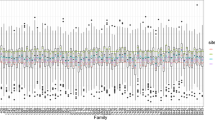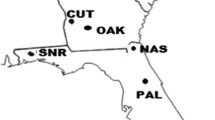Abstract
Cloned progeny tests in forest tree breeding provide the ability to assess the same genotypes across multiple environments and partition observed phenotypic variance into additive and non-additive genetic effects. In this study, 2362 clones from 53 crosses of loblolly pine (Pinus taeda L.) were tested across eight locations in the Southern US. Alpha cyclic incomplete row-column design was used to accommodate a large number of clones in a replication. Tree stem volume (cubic decimeter) was assessed at age 6 using various variance-covariance structures of mixed models. Models with factor analytic additive genetic structures and spatially correlated residuals or polynomial fixed row and column effects efficiently captured heterogeneity in the data. The narrow-sense clone mean heritability estimate for stem volume was 0.41 for the simple compound symmetry additive genetic structure. The estimates were higher for more complex models, ranging from 0.56 to 0.61. Non-additive genetic variance for stem volume was about a fraction of the additive genetic variance, suggesting that the trait is mainly controlled by large number of genes each with small effect. The results suggested that for forest trees genetic field tests with large number of genetic entries, breeders should consider incomplete row-column designs to model micro-site heterogeneity in two directions. These designs allow spatial modeling using row and column information, which can efficiently account for heterogeneity in the environment, resulting in higher heritability estimates and more reliable ranking of varieties for selection.





Similar content being viewed by others
References
Baltunis BS, Huber DA, White TL, Goldfarb B, Stelzer HE (2006) Genetic analysis of early field growth of loblolly pine clones and seedlings from the same full-sib families. Can J For Res 37:195–205
Beeck CP, Cowling WA, Smith AB, Cullis BR (2010) Analysis of yield and oil from a series of canola breeding trials. Part I. Fitting factor analytic mixed models with pedigree information. Genome 53:992–1001
Burdon RD, Shelbourne CJ (1974) The use of vegetative propagules for obtaining genetic information. N Z J For Sci 4:418–425
Carson MJ (1986) Advantages of clonal forestry for Pinus radiata - real or imagined. N Z J For Sci 16:403–415
Chen ZQ, Karlsson B, Wu HX (2017) Patterns of additive genotype-by-environment interaction in tree height of Norway spruce in southern and Central Sweden. Tree Genet Genomes 1:13–25
Costa e Silva JJ, Potts BM, Dutkowski GW (2006) Genotype by environment interaction for growth of Eucalyptus globulus in Australia. Tree Genet Genomes 2:61–75
Crossa J, Burgueño J, Cornelius PL, McLaren G, Trethowan R, Krishnamachari A (2006) Modeling genotype × environment interaction using additive genetic covariances of relatives for predicting breeding values of wheat genotypes. Crop Sci 46:1722–1733
Cullis BR, Smith AB, Beeck CP, Cowling WA (2010) Analysis of yield and oil from a series of canola breeding trials. Part II. Exploring variety by environment interaction using factor analysis. Genome 53:1002–1016
Cullis BR, Jefferson P, Thompson R, Smith AB (2014) Factor analytic and reduced animal models for the investigation of additive genotype-by-environment interaction in outcrossing plant species with application to a Pinus radiata breeding programme. Theor Appl Genet 127:2193–2210
Eriksson G, Ekberg I, Clapham D (2006) An introduction to forest genetics, Second edn. Genetic Center, Department of Plant Biology and Forest Genetics, SLU Sweden, pp 130–139
Farjat AE (2015) Prediction of genetic merit in a clonal population of loblolly pine. In optimal seed deployment under climate change using spatial models and prediction of genetic merit in loblolly pine (doctoral dissertation). pp 74–105 Retrieved from NCSU libraries https://repository.lib.ncsu.edu/handle/1840.16/11433. Accessed 3/1/2017
Foster GS, Shaw DV (1988) Using clonal replicates to explore genetic variation in a perennial plant species. Theor Appl Genet 76:788–794
Frampton LJ Jr, Foster GS (1993) Field testing vegetative propagules. In: Clonal forestry I, genetics and biotechnology. Springer, Berlin, pp 110–134
Gezan SA, White TL, Huber DA (2006) Comparison of experimental designs for clonal forestry using simulated data. For Sci 52:108–116
Gezan SA, de Carvalho MP, Sherrill J (2017) Statistical methods to explore genotype-by-environment interaction for loblolly pine clonal trials. Tree Genet Genomes 13:1–11
Gilmour AR, Gogel BJ, Cullis BR, Welham SJ, Thompson R (2015) ASReml user guide release 4.1 structural specification. VSN International Ltd, Hemel Hempstead
Hardner CM, Dieters M, Dale G, DeLacy I, Basford KE (2010) Patterns of genotype-by-environment interaction in diameter at breast height at age 3 for eucalypt hybrid clones grown for reafforestation of lands affected by salinity. Tree Genet Genomes 6:833–851
Isik F, Li B, Frampton J (2003) Estimates of additive, dominance and epistatic genetic variances from a clonally replicated test of loblolly pine. For Sci 49:77–88
Isik F, Goldfarb B, LeBude A, Li B, McKeand S (2005) Predicted genetic gains and testing efficiency from two loblolly pine clonal trials. Can J For Res 35:1754–1766
Isik F, Maltecca C, Holland J (2017) Genetic data analysis for plant and animal breeding. Springer International Publishing, Cham
John JA (1987) Cyclic designs. Monographs on statistics and applied probability. Chapman & Hall, London, pp 61–92
John JA, Eccleston JA (1986) Row-column α-designs. Biometrika 73:301–306
John JA, Williams ER (1995) Cyclic and computer generated designs. Monographs on statistics and applied probability 38. Chapman & Hall, London, p 255
Li Y, Suontama M, Burdon RD, Dungey HS (2017) Genotype by environment interactions in forest tree breeding: review of methodology and perspectives on research and application. Tree Genet Genomes 13:60–78
Libby WJ, Rauter RM (1984) Advantages of clonal forestry. For Chron 60:145–149
Lynch M, Walsh B (1998) Genetics and analysis of quantitative traits, vol 1. Sinauer, Sunderland
McRae JB, Stelzer HE, Foster GS (1993) Genetic test results from a tree improvement program to develop clones of loblolly pine for reforestation. In The Proceedings of 22nd Southern Forest Tree Improvement Conference, 14–17 June 1993. Atlanta, GaNational Technical Information Services, Springfield, Va pp 424–433
Ogut F, Maltecca C, Whetten R, McKeand S, Isik F (2014) Genetic analysis of diallel progeny test data using factor analytic linear mixed models. For Sci 60:119–127
Patterson HD (1978) Routine least squares estimation of variety means in incomplete tables. J Nat Inst Agric Bot 13:42–51
Piepho HP, Williams ER (2010) Linear variance models for plant breeding trials. Plant Breed 129:1–8
Sherrill JR, Bullock BP, Mullin TJ, McKeand SE, Purnell RC (2011) Total and merchantable stem volume equations for midrotation loblolly pine (Pinus taeda L.). South J Appl For 35:105–108
Smith A, Cullis B, Thompson R (2001) Analyzing variety by environment data using multiplicative mixed models and adjustments for spatial field trend. Biometrics 57:1138–1147
Smith AB, Ganesalingam A, Kuchel H, Cullis BR (2015) Factor analytic mixed models for the provision of grower information from national crop variety testing programs. Theor Appl Genet 128:55–72
Team RC (2018) R: a language and environment for statistical computing. R Foundation for Statistical Computing, Vienna
Ukrainetz NK, Yanchuk AD, Mansfield SD (2018) Climatic drivers of genotype-environment interactions in lodgepole pine based on multi-environment trial data and a factor analytic model of additive covariance. Can J For Res 48:835–854
VanRaden PM (2008) Efficient methods to compute genomic predictions. J Dairy Sci 91:4414–4423
Weng Y, Park YS, Krasowski MJ (2010) Managing genetic gain and diversity in clonal deployment of white spruce in New Brunswick, Canada. Tree Genet Genomes 6:367–376
Wickham H (2016) ggplot2: elegant graphics for data analysis, 2nd edn. Springer-Verlag, New York
Williams ER, John JA, Whitaker D (2006) Construction of resolvable spatial row-column designs. Biometrics 62:103–108
Zapata-Valenzuela J (2012) Use of analytic factor structure to increase heritability of clonal progeny tests of pinus taeda L. Chilean J Agric Res 72:309–315
Acknowledgments
We would like to thank NC State University Cooperative Tree Improvement Program members (ArborGen, Rayonier, Plum Creek, CellFor, Westervelt, Georgia Forestry Commission, Weyerhaeuser, and NC Forest Service) for their efforts in establishing, management, and measurement of field trials throughout the study period. Thanks to NC State University Cooperative Tree Improvement Program managers Trevor Walker, Austin Heine, and former director Dr. Steve McKeand for the technical support, coordination, and data collection. We are also thankful to Eddie Lauer and Dr. Kitt Payn for providing useful editorial comments on the final version of the manuscript.
Funding
This research was funded by the United States Department of Agriculture (USDA) National Institute of Food and Agriculture (NIFA) project (Grant # 2011-68002-30185).
Author information
Authors and Affiliations
Contributions
Shalizi analyzed the data and wrote the first draft of the manuscript. Isik contributed to the modeling, writing, and interpretation. Both authors read and approved the final version of the manuscript.
Corresponding author
Ethics declarations
Conflict of interest
The authors declare that they have no conflict of interest.
Additional information
Communicated by J. Beaulieu
Publisher’s note
Springer Nature remains neutral with regard to jurisdictional claims in published maps and institutional affiliations.
Key message
An incomplete row-column experimental design was successful in accommodating a large number of genetic entries, estimating genetic variances and producing higher heritability estimates in a cloned loblolly pine population.
Appendix
Appendix
Rights and permissions
About this article
Cite this article
Shalizi, M.N., Isik, F. Genetic parameter estimates and GxE interaction in a large cloned population of Pinus taeda L.. Tree Genetics & Genomes 15, 46 (2019). https://doi.org/10.1007/s11295-019-1352-7
Received:
Revised:
Accepted:
Published:
DOI: https://doi.org/10.1007/s11295-019-1352-7




